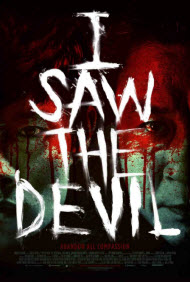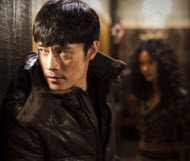I Saw the Devil
Reviewed by: Jim O'Neill
CONTRIBUTOR
| Moral Rating: | Very Offensive |
| Moviemaking Quality: |
|
| Primary Audience: | Adults |
| Genre: | Crime Drama Horror Thriller |
| Length: | 2 hr. 24 min. |
| Year of Release: | 2010 |
| USA Release: |
January 21, 2011 (festival) March 4, 2011 (limited) DVD: May 10, 2011 |








how to properly survive great personal loss
retribution / vengeance
REVENGE, love replaces hatred—former Israeli soldier and an ex-PLO fighter prove peace is possible-but only with Jesus Christ
depravity—fall of man to sin
serial killer—murder in the Bible
torture
about the real Devil
Is Satan a real person that influences our world today? Is he affecting you? Answer
evil in our world
FILM VIOLENCE—How does viewing violence in movies affect families? Answer
What are goodness and righteousness?
Why does God allow innocent people to suffer? Answer
What about the issue of suffering? Doesn’t this prove that there is no God and that we are on our own? Answer
Does God feel our pain? Answer
ORIGIN OF BAD—How did bad things come about? Answer
Did God make the world the way it is now? What kind of world would you create? Answer
| Featuring |
|---|
|
Byung-hun Lee—Kim Soo-hyeon Gook-hwan Jeon … Squad Chief Jang Ho-jin Jeon … Section Chief Oh San-ha Oh … Joo-yeon Yoon-seo Kim … Se-yeon Min-sik Choi … Kyung-Chul |
| Director |
 Jee-woon Kim |
| Producer |
|
Kee-young Cheong—co-executive producer Hyung-cho Il … co-executive producer Hun-you Jeong … executive producer See all » |
| Distributor |
| Magnet Releasing |
“Evil lives inside.”
A preacher once said:
“Tell me what you hate, and I’ll show you what you are”.
The more we hate our enemies, the more like them we become. One of our presidents warned us against hating our foes:
“If someone hates you, don’t hate them back; because when you do, they have won”.
“I Saw the Devil”, the new film by Korean director, Kim Jee-woon (“The Good, The Bad, and the Weird,” “A Tale of Two Sisters”) is a study of loss, anger and revenge. Mostly revenge. Hollywood has made this kind of movie before. The “Dirty Harry,” “Death Wish” and “Lethal Weapon” franchises showed us that man can be consumed by an anger that, unchecked, can overcome him. In those movies, anger doesn’t quite overcome. It lets the hero break free, and it lets us blow off some steam from the comfort of our multiplex seat. In reality, that kind of anger doesn’t let us break loose; it makes us break down.
Those movies do entertain, and they touch a nerve; we can feel the release without our faces turning red and our minds clouding up (anger is a hard sin to hide), but, in the end, those tales are shallow. They may hit us in the gut, while we watch them, but they don’t haunt us or make us question why we needed that release in the first place. After awhile, those films become clichés. “Make my day” is now more of a joke than a warning.
“I Saw the Devil” does haunt. It’s disturbed and disturbing, and does not let its audience enjoy anything close to release. Justice by our own hands is no justice at all. In seeking our own retribution, we may get even, but we never get ahead.
The film is eerie and threatening from the start. A pair of plastic angel wings blink on the windshield of a van that approaches a disabled car parked on the side of a snow covered road. Inside the car, a woman waits for help. The driver of the van is not there to help her. The scene moves slowly and quietly: the van creeps forward, the snow drops like feathers from the sky, and those angel wings go on and off as though the batteries are fading. The atmosphere has that same unsettling feeling as the opening of Fritz Lang’s “M” when a child goes missing and the awareness of a horror comes when we see everyday objects, ones that are usually comforting, quickly take on an unsettling aspect. The slithering pace reflects the driver’s slow but methodical thought process. The killer is carefully going through the paces before he strikes.
The pace quickens when he does strike. A windshield breaks, and the night silence is shattered. The snow is soon soaked with blood.
The woman’s abduction does not end on the road. The abductor takes her back to his lair, a hideous, blood-stained den, where he tortures, murders and dismembers her. Think of being taken into Buffalo Bill’s house in “Silence of the Lambs” and having to watch him actually do to his victims what was described, but never actually shown on the screen. Everything is shown in “I Saw The Devil”. I had to turn my eyes away several times, especially when the victim pleads for her life and tells her attacker that she is pregnant. The violence is hard-hitting and gruesome, and it never relents.
The killer, Kung-chul, is played by Choi Min-sik, who gave a performance in “Oldboy” (2004) that was taut, frightening and often funny. He goes over the top in “…Devil”. He drips sweat and blood as he chases and gets chased; he too often looks as crazed as Robert De Niro did in “Cape Fear,” and doesn’t have enough quiet moments when he really shines and really scares, as when he glares with consummate contempt at a pharmacist who laughs at him, or when he shows a young woman a tire iron and asks her softly, “Do you know what this is for?”
The victim’s fiancé, Dae-hoon, works for the South Korean secret service. He is played by Lee Byung-hyun (“The Good, The Bad, and The Weird”). Lee’s young and handsome face doesn’t have the lines that gave Eastwood’s and Bronson’s their gravity and character. He doesn’t have the outward scars that would reveal he knows what it means to lose something. He has the look and the posture of someone whom one of today’s celebrities would call “winning.” Lee has to rely on his acting skills, which are almost as considerable as Choi’s, to get us to feel what he wants us to feel.
Black-suited, holster bearing, and earpiece fitted, he has the rigid, unreadable look of any of those guys we see who walk around lobbies with mini-microphones in their ears. Dae-hoon slips out from behind the mask when he softly croons a love song over his cell phone to his fiancé, as she waits for a tow truck on an abandoned road, and especially when he sheds tears at her funeral. He throws that mask away when he goes in pursuit of her killer.
The victim’s father is a retired policeman. Both he and Dae-hoon are present when the girl’s body parts are found in a river. The discovery scene is a bonfire of humanity, at its most chaotic and confused. The victim’s humanity is forgotten in the maelstrom; she is pursued and dissected, all over again. The father’s grief, as well as the woman’s sister’s, are intense, but contained. They live a Christian life, something that is not spoken, but evidenced by the religious articles, including a cross, that abound in their home. The father and daughter are brought low by grief, but their love, and undoubtedly their faith, unite and strengthen them. They do not let their sorrow overcome them. Instead, they devote themselves to protecting and helping their would be son-in-law, whom they know is a danger to himself.
They are the moral grounding of the story, and represent the contrast between righteous and sinful anger. Their anger is controlled, and it has a purpose. It is an anger that is grounded in an understanding of God’s plan and a will to live. Dae-hoon’s anger lacks all understanding; he doesn’t care whether he or anyone else lives or dies. His wrath is out of control, and ultimately purposeless.
Dae-hoon finds the killer, but does not bring him to the police. He doesn’t kill him, either. He plants a homing device inside him, setting up a sadistic cat and mouse game, so he can pursue the killer who continues to search for and find other victims. Sometimes, but not always, he stops Kung-chul in the act. He tortures and cripples him (first cutting a wrist tendon, later cutting an Achilles tendon), and sends him on his way, allowing him to terrorize more women, and to be caught all over again.
The pursuer cannot stop hunting, because he can’t find an end to the game he started. When the end does come, he knows that he has become what he has hunted. His hatred has not ebbed; it has grown, while everything else about him has diminished. He ultimately carries out a crime that is far worse than anything the killer had conceived. He finds no release, no sense of justice, and no disgust at a world gone bad. His disgust is all inside, and he finds no escape from that. He found the “heart of darkness,” and he destroyed it, but he had to destroy his own heart in order to do so.
Anger is as hard to understand as it is to control. On the cross, Christ asks the question “My God, My God, Why have you forsaken me?” Those words sound angry and hopeless, but they were spoken by God, so how can God be angry at God? We know He’s not. And He is not angry at us. What He is angry at is our sins. He taught us how to use anger and how to direct our anger, how to use it and not how to lose it. And He also taught us how to forgive. He forgave our anger, when we stood under His cross with spears, vinegar and dice, and, with clenched fists, crying out for blood.
“I Saw The Devil” is full of extreme violence, including dismemberment, disfigurement, and even cannibalism. Particularly frightening is watching another serial killer consume his victims, as his pale, anemic girlfriend sits at the table watching, waiting, and sensing that she could easily wind up as her boyfriend’s next meal. Despite its graphic detail, the film is an indictment of sinful anger and revenge, and another example of the bold and inventive filmmaking that is coming from South Korea these days. I wish American films had this kind of conviction. And nerve.
Violence: Extreme / Profanity: Heavy / Sex/Nudity: Heavy
See list of Relevant Issues—questions-and-answers.


PLEASE share your observations and insights to be posted here.
Speaking of which, it’s ironic that I mentioned “Oldboy” because when that film’s director, Park Chanwook, won a Grand Prix Award for the movie in 2004 and a journalist asked him why he was repeatedly using the theme of revenge in his movies, Mr. Park said that he was doing so in order to show the destructive futility of revenge and the destruction and detriment it brings to everyone involved. That sentiment is subtly and powerfully echoed in Kim Jeewoon’s “I Saw The Devil,” and, again, it’s a sentiment I applaud. The Bible clearly tells us in both Deuteronomy 32:35 and Romans 12:19 to leave revenge where it belongs—in the Hands of God, and said so for a reason.
Just like the main reviewer said, justice in our own hands is no justice at all. We’re flawed human beings who mess up and miss the mark on a daily basis, and real, true justice only comes from Jesus Christ, since He’s the Only One Who is perfect. Thus, whenever we try to play God and take justice into our own hands, that’s when we get in trouble and set ourselves up for destruction along the way. See all »
My Ratings: Moral rating: Very Offensive / Moviemaking quality: 5